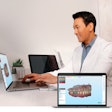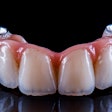A team of Cardiff University clinicians and computer scientists are using 3D surface motion imaging to study facial movement and transform the way patients needing facial surgery are assessed and monitored.
Research into facial movement has important applications in patients whose facial movement is affected by conditions such as a cleft lip or neurological conditions such as Parkinson's disease, or someone who has experienced a stroke, the researchers noted in a press release. While videos have generally been the preferred method for recording facial movements, unfortunately, they are only 2D, so when analyzing how the face moves, important data are lost, they added.
In 2005, the Cardiff team commissioned the first commercial 3dMD scanner capable of recording moving human images. This year, Cardiff purchased two next-general systems from 3dMD to further their research efforts.
"When 3dMD's technology first became available, our team was determined to move from 2D to 3D video to measure with precision the dynamic aspects of facial soft-tissue movement and expression," said David Marshall, PhD, a professor in the Cardiff University Computer Science and Informatics Department. "Research into more general 3D dynamic facial expression analysis and their application to biometric identification, expression recognition, and computer graphics and animation has also been productive."



















